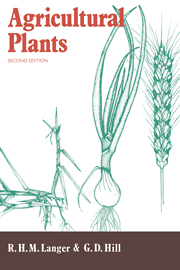Book contents
- Frontmatter
- Contents
- Preface to the first edition
- Preface to the second edition
- 1 World population and crop production
- 2 Plant structure
- 3 Liliaceae
- 4 Poaceae
- 5 Apiaceae
- 6 Asteraceae
- 7 Brassicaceae
- 8 Cannabinaceae
- 9 Chenopodiaceae
- 10 Cucurbitaceae
- 11 Fabaceae
- 12 Lamiaceae
- 13 Linaceae
- 14 Malvaceae
- 15 Papaveraceae
- 16 Solanaceae
- 17 Physiological basis of yield
- Index of specific names
- Subject index
1 - World population and crop production
Published online by Cambridge University Press: 05 June 2012
- Frontmatter
- Contents
- Preface to the first edition
- Preface to the second edition
- 1 World population and crop production
- 2 Plant structure
- 3 Liliaceae
- 4 Poaceae
- 5 Apiaceae
- 6 Asteraceae
- 7 Brassicaceae
- 8 Cannabinaceae
- 9 Chenopodiaceae
- 10 Cucurbitaceae
- 11 Fabaceae
- 12 Lamiaceae
- 13 Linaceae
- 14 Malvaceae
- 15 Papaveraceae
- 16 Solanaceae
- 17 Physiological basis of yield
- Index of specific names
- Subject index
Summary
World population statistics make terrifying reading, so rapid has the rise in numbers become. It was not always like this, because for many centuries war and famine, disease and natural disaster kept increases at a reasonable level. Not only that, but any local pressure on land and other resources could always be countered by migration and the colonisation of new areas. But, in the last few decades, the picture has changed dramatically, and we are now acutely aware of the dire consequences of overcrowding, both regionally and internationally. The population explosion, which Malthus so gravely predicted and described, has occurred and, whether we are prophets of doom or confident technocrats, we have to face the future with realism.
As recently as the middle of this century, well within the life span of many people living today, the total world population was about 2400 million. Forty years later it had reached 5300 million, and the curve continues to rise, climbing inexorably into the future (Fig. 1.1). The present increase per day is about 250 000, the size of a medium city, and at this rate 90 million new people are added every year, more than enough to populate an entirely new country.
United Nations' estimates predict that there may be 10 000 million people on Earth by the year 2050, but this rate of increase could well be exceeded.
- Type
- Chapter
- Information
- Agricultural Plants , pp. 1 - 9Publisher: Cambridge University PressPrint publication year: 1991



